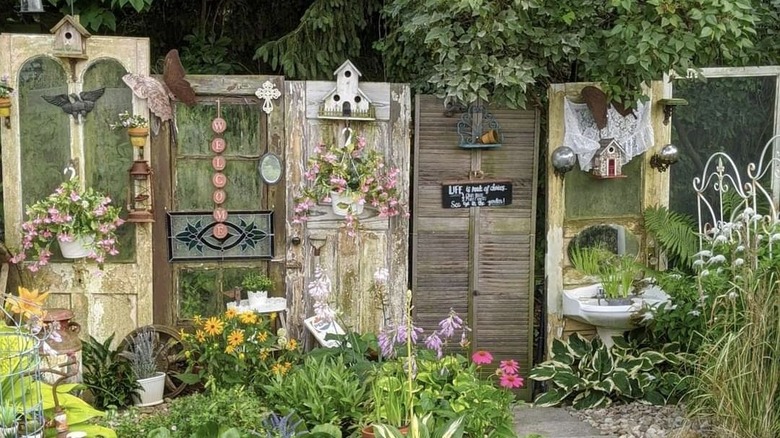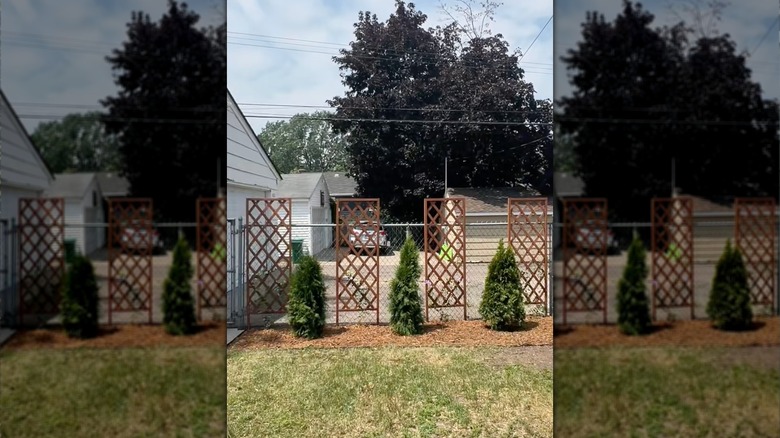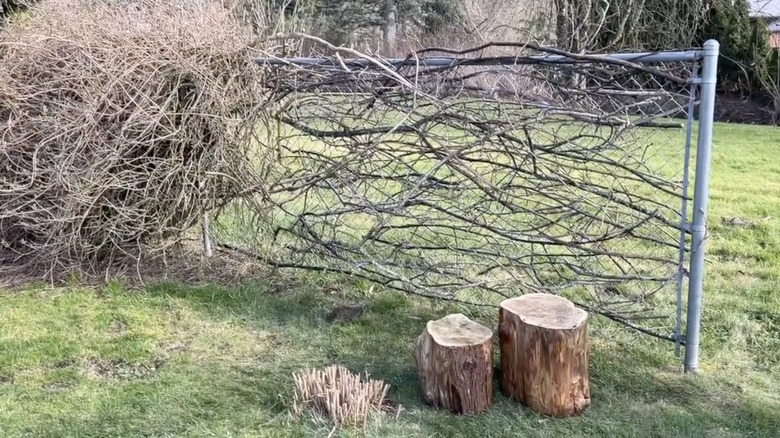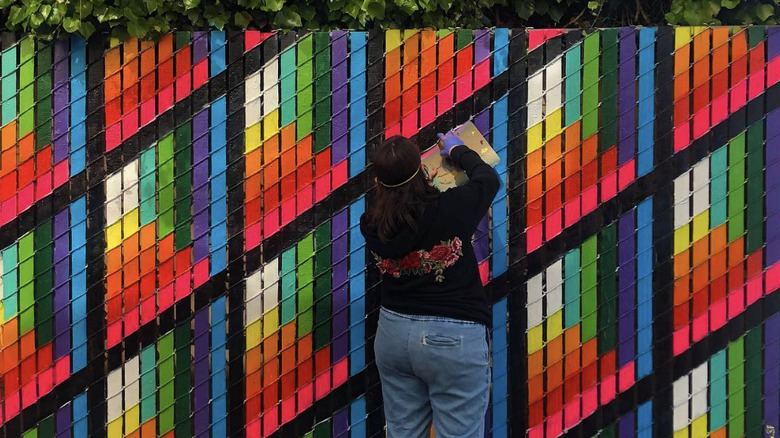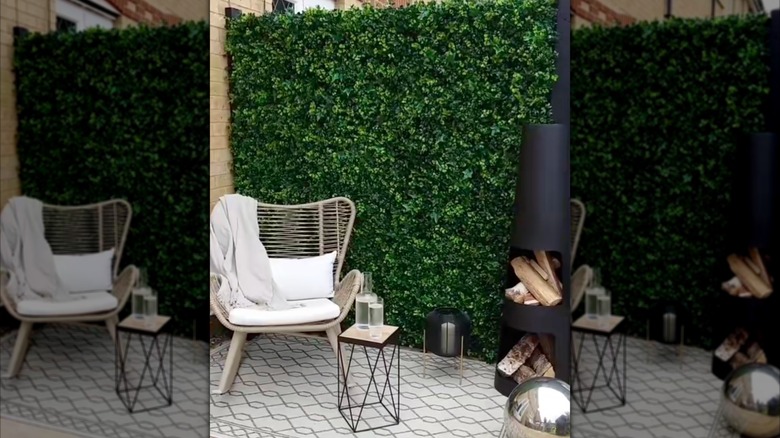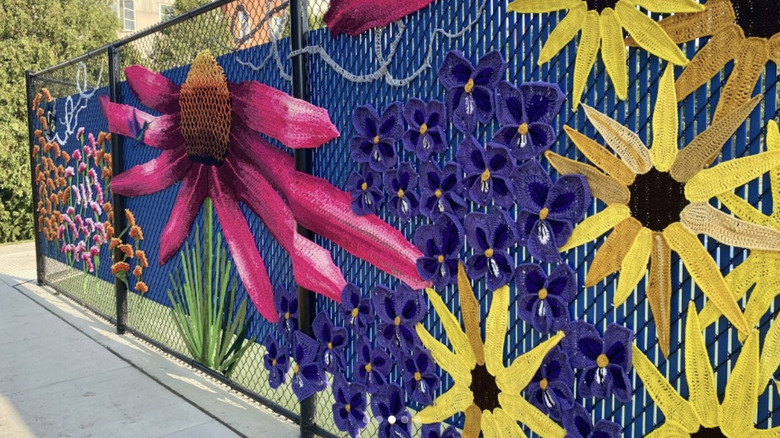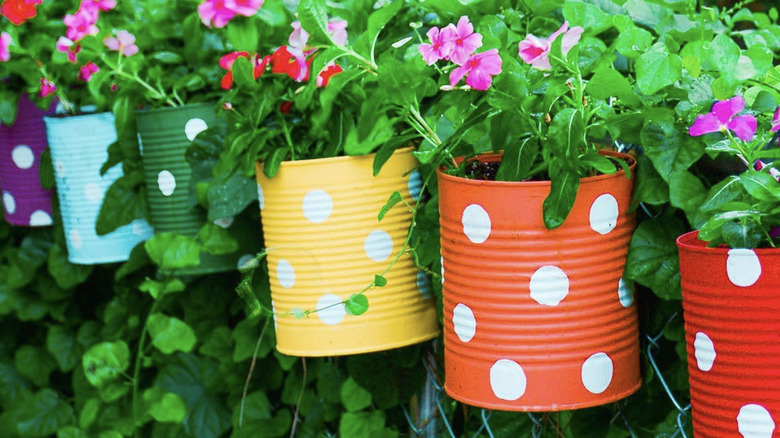8 Ways To Upgrade An Ordinary Chain-Link Fence To Elevate A Yard Or Garden
Since the late 1800s, chain-link fences have been used around public areas, homes, and businesses. Their durability, affordability, and low maintenance have made them a popular choice over the decades, even with a number of newer materials and designs on the market. However, while chain-link fences may keep intruders out of your yard or protect animals and kids from straying, they also can give off an "abandoned corner lot" vibe. They also don't offer any privacy, nor are they particularly appealing to look at, which can impact how much you can truly relax in your backyard oasis.
If your home is surrounded by a chain-link fence that you aren't fond of, you don't have to begrudgingly live with it — nor do you need to remove it. Think about how you can take advantage of the structure and use it for your benefit. For example, consider growing vegetables on your fence or using it as a trellis for climbing plants. Depending on your budget, your interest in creative projects, and favored style for your yard, here are some additional options for upgrading an ordinary chain-link fence.
Add vintage doors
Add a few vintage doors around your yard or completely cover one section of the fence for a touch of whimsy. Leave doors in their original condition for a rustic look, or repaint them for an updated appearance. To protect the doors from the elements, treat them with a water-based stain with UV inhibitors and set them on bricks if they're resting on dirt. Use a C-clamp to secure the doors to the fence. Leave them plain for a subtle, minimalist vibe, or decorate the doors with birdhouses, wind chimes, lights, and planter boxes for character.
Disguise a fence with decorative panels
An easy way to upgrade a chain-link fence is with a decorative panel or a trellis for privacy to make the fence less noticeable. Choose a material and design that fits your style, color, and desired level of privacy. Options include wood, plastic, or metal panels in a classic lattice pattern, simple slats, geometric shapes, laser-cut foliage, and more. Some have built-in planter boxes that can be filled with annuals or climbing plants that will grow upward and fill in the entire panel. Install garden lights at the bases for added elegance.
Weave branches through the fence
If you just finished an afternoon of hefty pruning, make use of the cut branches by weaving them into a chain-link fence. This will give your fence an earthy, rustic look. Leave the branches bare, or decorate them with ribbon, charms, cut flowers from your garden, or wind chimes. Start by placing the thickest branches first, evenly spacing them out across the fence. If they're too thick to weave, simply zip-tie them onto the fence. Next, fill in the gaps with twigs that can be tucked throughout the fence and other branches.
Turn the fence into painted artwork
Inserting wood slats into your fence will give you instant privacy, but if you want to elevate this standard look, get out your paint supplies. You could mirror your house color if you want uniformity between your home and yard. You could also choose a color that complements your house or another color found in other areas of your yard — like your deck furniture, a bright door, or a planter in your garden. Feeling bold? Turn the wood slats into artwork by painting a vibrant pattern across the whole fence or just one section.
Create a greenery wall
Although it feels blasphemous to recommend artificial plants to gardeners, affixing panels of faux greenery could work. They add color and texture without requiring the care that real plants need. Just spray them down several times a year to remove dust and dirt. Many greenery panels look like boxwood hedges or other small-leafed plants, which helps to avoid the appearance of an overgrown jungle. (If that's your aesthetic, we won't judge.) To visually break up the greenery, plant flowers in large planters in front of some of the panels, selecting colors that contrast the verdant backdrop.
Make textile art
Decorating a chain-link fence with textiles is one of the more time-intensive options, but the results will be rewarding. Engage your artistic side by tying ribbon, surveyor's tape, or fabric strips to the fence to form geometric shapes or an actual image. Ambitious knitters and crocheters could create large-scale pieces, like the pictured flowers, to place on the fence. This option will give your yard color, texture, and movement, depending on the materials you choose. For intricate images, try sketching out the design first on axonometric graph paper, which offers the 45-degree diamond shapes of chain-link fences.
Grow a living bamboo screen
Although many gardeners steer clear of bamboo, there are different kinds of bamboo — and not all need to be avoided. The clumping type is noninvasive and safer to grow than the more prolific running bamboo. Although clumping bamboo doesn't need to be grown in containers, this can keep the plant under control. Plus, the planters will add visual interest along your fence. Most clumping bamboos grow well in USDA Hardiness Zones 7 and 8, although some — like 'Green Panda' bamboo (Fargesia rufa 'Green Panda') and scabrida bamboo (Fargesia scabrida) — can be grown in colder climates.
Take advantage of additional planting spaces
If your patio, planters, and yard are at capacity, don't discount the extra space your chain-link fence can offer. You'll gain extra planting areas while also enhancing the fence. This option may leave you floored by all the possibilities: Narrow window boxes for groupings of annuals, small containers for compact succulent displays, and dangling planters placed at various levels, among the many selections. Make your own planters by painting tin cans, drilling drainage holes at the bottom and a hole along the top edge, and hanging the can onto the fence with an S-hook.

